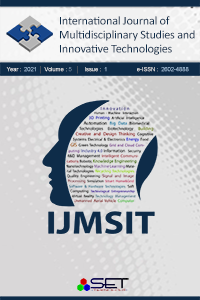Abstract
References
- [1.] ICAO, Doc 10020 Manual of Electronic Flight Bags (EFBs). 2018.
- [2.] Hart, S.G., Nasa-Task Load Index (Nasa-TLX); 20 Years Later. Proceedings of the Human Factors and Ergonomics Society Annual Meeting, 2006. 50(9): p. 904-908.
- [3.] Divya C. Chandra, M.Y., Vic Riley, Susan J. Mangold, Human Factors Considerations in the Design and Evaluation of Electronic Flight Bags (EFBs). 2003.https://rosap.ntl.bts.gov/view/dot/8815
- [4.] Winter, S.R., et al., Pilot performance comparison between electronic and paper instrument approach charts. Safety science, 2018. 103: p. 280-286.
- [5.] Milner, M.N., et al., The Effect of Chart Type on Pilots’ Response Time. Proceedings of the Human Factors and Ergonomics Society Annual Meeting, 2017. 61(1): p. 1365-1368.
- [6.] EASA, Research Project: EFB Electronic Flight Bag Aircraft performance calculations and mass & balance Best practices for evaluation and use of EFB. 2015.
- [7.] Krug, S., Rocket Surgery Made Easy: The Do-It-Yourself Guide to Finding and Fixing Usability Problems. Berkeley, CA: New Riders. pp. 147-152, 2010.
- [8.] Ho, A.D. and C.C. Yu, Descriptive Statistics for Modern Test Score Distributions: Skewness, Kurtosis, Discreteness, and Ceiling Effects. Educational and psychological measurement, 2015. 75(3): p. 365-388.
- [9.] Kim, H.-Y., Statistical notes for clinical researchers: assessing normal distribution (2) using skewness and kurtosis. Restorative dentistry & endodontics, 2013. 38(1): p. 52.
EVALUATION OF JEPPESEN AND GARMIN ELECTRONIC FLIGHT BAGS (EFBs) APPLICATIONS IN TERMS OF COGNITIVE WORKLOAD AND AVAILABILITY
Abstract
As the dimensions and capabilities of tablet computers are suitable for use in aircraft, software has begun to be developed. The approach plans and route information used on printed paper about the airports in flight operations have been transformed into a paperless flight deck concept [1] by means of the development of appropriate software. With the introduction of the paperless cockpit concept, pilots can access the information they need through the tablet and the applications installed in it. Together with the paperless cockpit concept, the physical workload of the pilots on the physical document handling and document up-to-date works has virtually disappeared. However, the disappearance of the physical workload was replaced by the cognitive workload. To use the capabilities of EFBs applications practically, it is important to develop applications to minimize the cognitive workload. Cognitive load analysis and usability studies were conducted by using NASA-TLX and IBM CSUQ questionnaires between JEPPESEN FD PRO application used by participating pilots and GARMIN PILOT application which pilots had not used before. User tests were performed on two different groups. The first group consists of 15 pilot working on light-middle class transport aircraft. The second group consists of 15 flight technicians working in light-middle class transport aircraft. NASA-TLX and IBM CSUQ questionnaires were applied to both groups and the results were analyzed in SPSS program
References
- [1.] ICAO, Doc 10020 Manual of Electronic Flight Bags (EFBs). 2018.
- [2.] Hart, S.G., Nasa-Task Load Index (Nasa-TLX); 20 Years Later. Proceedings of the Human Factors and Ergonomics Society Annual Meeting, 2006. 50(9): p. 904-908.
- [3.] Divya C. Chandra, M.Y., Vic Riley, Susan J. Mangold, Human Factors Considerations in the Design and Evaluation of Electronic Flight Bags (EFBs). 2003.https://rosap.ntl.bts.gov/view/dot/8815
- [4.] Winter, S.R., et al., Pilot performance comparison between electronic and paper instrument approach charts. Safety science, 2018. 103: p. 280-286.
- [5.] Milner, M.N., et al., The Effect of Chart Type on Pilots’ Response Time. Proceedings of the Human Factors and Ergonomics Society Annual Meeting, 2017. 61(1): p. 1365-1368.
- [6.] EASA, Research Project: EFB Electronic Flight Bag Aircraft performance calculations and mass & balance Best practices for evaluation and use of EFB. 2015.
- [7.] Krug, S., Rocket Surgery Made Easy: The Do-It-Yourself Guide to Finding and Fixing Usability Problems. Berkeley, CA: New Riders. pp. 147-152, 2010.
- [8.] Ho, A.D. and C.C. Yu, Descriptive Statistics for Modern Test Score Distributions: Skewness, Kurtosis, Discreteness, and Ceiling Effects. Educational and psychological measurement, 2015. 75(3): p. 365-388.
- [9.] Kim, H.-Y., Statistical notes for clinical researchers: assessing normal distribution (2) using skewness and kurtosis. Restorative dentistry & endodontics, 2013. 38(1): p. 52.
Details
| Primary Language | English |
|---|---|
| Subjects | Engineering |
| Journal Section | Articles |
| Authors | |
| Publication Date | July 31, 2021 |
| Submission Date | June 7, 2021 |
| Published in Issue | Year 2021 Volume: 5 Issue: 1 |


